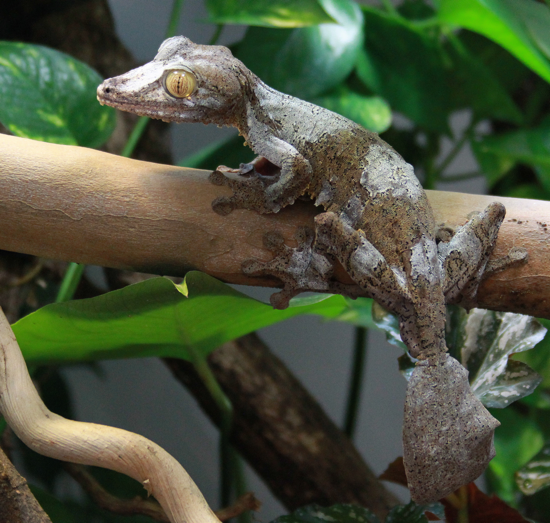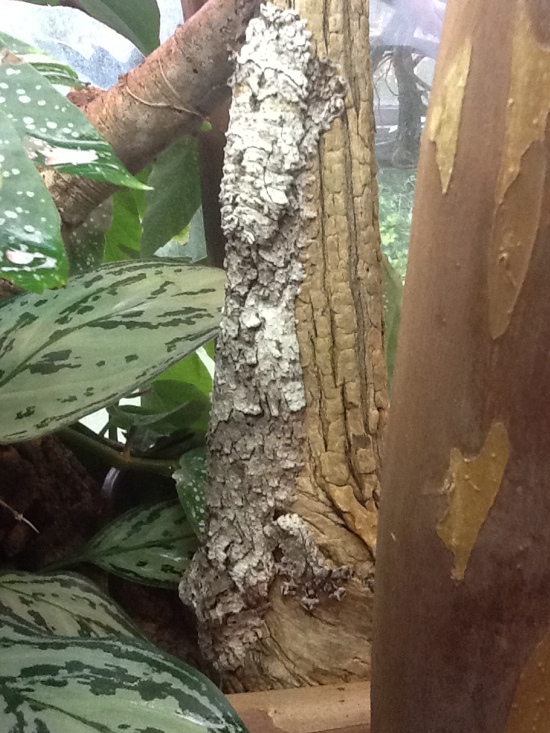[ad#superworms]
Our second installment of Three to Get Ready focuses on the genus Uroplatus, commonly called the “Leaf Tail Gecko”. As you will see, Uroplatus geckos seem to stir up intense devotion in those who choose to keep them, as they are not easy to care for.
Once again, the three herpers who give us a peek into the world of Uroplatus have all responded to the following questions:
- What species are you keeping?
- What got you interested in this species and where did you get your first?
- How are they set up? Describe your enclosure.
- What do you find most interesting about them?
- What do you find to be the biggest challenge?

Kevin Smith
I currently keep Uroplatus- Fimbriatus, Henkeli, Lineatus, Sameiti and Sikorae
My interest in the Genus Uroplatus began when I stumbled upon a picture of a Uroplatus Phantasticus a few years ago while searching for gecko pictures. I was looking for more challenging species to get into and that one picture, along with some Fimibriatus photos really appealed to me. It didn’t take me long to find out about their fragility and huge mortality rate in the hobby. This initially intimidated me, but in 2010 when I saw the CITES export quotas were being drastically reduced I knew it was now or never, so I decided to start looking for animals.
I bought my first Uroplatus, a Fimbriatus, from Steve Hoch of Geckoholic Reptiles.
My setups are still evolving, but currently most of my breeders are housed in vertically oriented, converted plastic tubs with screen fronts and sides. I use LECA substrate with Zilla Jungle Mix separated by landscaper’s mesh. Each enclosure has several vertically oriented branches, along with some pothos and sansevieria plants. Most of my females use the layboxes I give them. My hatchlings are housed by clutches in smaller enclosures set up similarly to the breeder tanks. The herp room is separate from the rest of the house and I use three separate light timers set sequentially to simulate dusk/dawn- the main light, then the hatchling/other gecko lights, then the Uroplatus breeders. I use fluorescent strip lights with one plant grow bulb and one 5.0 UVB in the fixture. The room is temperature controlled when necessary.
I love the looks of all Uroplatus species, but find their behavior to be even more interesting. From their voracious appetites to watching the females roll the eggs with their hind feet until perfectly round, Uroplatus are interesting to watch when both active and inactive.
However, the thing that really made me dedicate my resources to Uroplatus is that there are so few keepers seriously working to keep and produce them responsibly. Wild Caught imports could stop within the next few years, so if we want to have them around for years to come somebody has to do the hard work of building a genetically diverse captive population now. It’s also my hope that their fragile nature and natural beauty somewhat insulates them from the morph-driven madness that has so engulfed other species in the hobby.
I’ve had good success in my keeping and breeding, so now my attention turns toward getting the animals I’ve produced into the hands of thoughtful and capable herpers who can in turn produce more animals. I’m producing and will be offering only unrelated pairs, but finding others who will do the same is something I’m somewhat pessimistic about.
From a husbandry standpoint, I find my biggest questions still lie around tweaking the supplementation regimen, seasonal/breeding cycles and managing the parasites so prevalent in wil-caught animals. Only time will tell if what I’m doing will work in the long run, but so far things are going pretty well.
Jay Markert
I work with and breed Uroplatus Sikorae, Lineatus, Henkeli, and Fimbriatus.
I got interested in Uroplatus after seeing a picture of them on the cover of a trade magazine in 2000. At that time we were breeding chameleons and had been doing so for over 13 years ; we had the perfect conditions to try to breed Uroplatus. After a few months of research on Uroplatus, I discovered that there was a high demand ,yet not many breeders. Despite some negative feedback on WC (Wild Caught) Uroplatus ,we purchased some from an importer in 2000. The WC Uroplatus would come in dehydrated, stressed and full of parasites.
In 2001 we hatched out our first U. sikorae ; that was the start. We sold all our chameleons and started buying Uroplatus. In 2003 we expanded the operation by buying other species and had great success in raising them. We keep our smaller Uroplatus in a 18x18x24 Exo-terra tank. It’s heavily planted with vertical and horizontal branches. We spray the enclosures heavily at night to increase the humidity The rooms are kept at 75F for summer day time highs. Nighttime lows are around 65F-70F.
Among breeders there is a lot of discussion about the amount of UV the Uroplatus genus requires. We use a full spectrum bulbs with calcium D3 supplements on a weekly basis.
There is a critical need to increase the number of breeders if this beautiful species is to survive. The diminishing numbers of Uroplatus in Madagascar, its original habitat, along with the exportation for the pet trade, has created a great sense of urgency.
Luis Wiedemann
We work with most of the available species of Uroplatus. currently we’re working with:
◊ Uroplatus sp. nov. aff. ebenaui
◊ Uroplatus henkeli
◊ Uroplatus guentheri
◊ Uroplatus aff. henkeli
◊ Uroplatus fimbriatus
◊ Uroplatus sikorae
◊ Uroplatus sameiti
◊ Uroplatus phantasticus
◊ Uroplatus lineatus
I’ve known about Uroplatus for many years but having taken a 10-year hiatus from keeping reptiles, I never sought to work with them like we are now. We first saw them at a friend’s greenhouse. He had (what seemed like) hundreds of a variety of Uroplatus species available and we instantly fell in love with U. lineatus. It wasn’t long after that we acquired our first trio of U. lineatus and U. fimbriatus and the rest is history.
Since we are based in Florida, we utilize screen cages for the majority of our Uroplatus. This allows us better climate control and the ability to move and clean cages with ease. Most cages are 22x18x36″ and offer plenty of room for the majority of species. Hatchlings are housed in 12x12x18″ Exo-Terra enclosures until they’re old enough to be moved into their own screen enclosures. All enclosures are lit with a plant bulb and 5.0 UVB bulb and misted multiple times per evening.
Despite their obvious beauty, the lack of knowledge about Uroplatus really intrigued me. It was obvious that the more popular this genus became the more we needed a centralized location for all husbandry and related information to reside. The Uroplatus Information Center (http://www.uroplatus.org) was launched in an effort to share the knowledge we obtained by keeping these animals as well as to provide a resource for those interested in learning more. There is still a great deal to learn and I enjoy finding and sharing this information.
Due to the lack of research and information, we found the nutritional requirements of the different species the biggest challenge. In the past, Uroplatus were all treated the same, with the exception of a few temperature differences. Now we’re learning that different species require more or less supplementation than other species. For instance, U. sikorae will easily develop edema or become obese when over supplemented while U. henkeli may crash under the same schedule.

Bios
Jay Markert: I was born in Georgia in 1970. We lived in Columbus where I attended school. Llater, at the age of 14, I moved to Nashville , TN, graduating from Glencliff High School.
During my early years , in Columbus, at about the age of six or so , I often went to a small lake just blocks from my home . Soon, I saw that they were starting to build a highway near the lake. In time, they began filling in the lake and on one occasion I found a large snapping turtle roaming around as if he were looking for water. His habitat was gone. I brought the turtle home, and my Dad and I built an area in the back yard complete with a small pond. A few months later he escaped, was later found in a neighbor’s yard, and ended up in a zoo. That began my love for reptiles.
At the age of 14, living with my Dad in Nashville on the bank of a large creek, I would spend a lot of time in and around the creek with my brother and friends looking for reptiles. By 1989 I had begun raising chameleons and did very well with them.
During and after high school I started my own landscaping company. Later, in 2000, I went to work for the Nashville Zoo. At the zoo, I was responsible for pond construction and maintenance, and later started caring for the reptiles.
Check out Jay’s website www.uroplatusspecialties.com.
Kevin Smith is a self-employed finish carpenter in the Boston, MA area. He’s been keeping reptiles for several years now, but the recent jump from leopard geckos and Rhacs to Uroplatus is the first serious gecko keeping he’s done and he still feels like a noob most days. He doesn’t have any free time, but if he did he would love to go backpacking with his lovely wife and three children. At the time this article was published, he has 12 Uroplatus hatchlings and 15 eggs incubation from two species and will be offering unrelated pairs of F1 Henkeli later this year. Individual Fimbriatus will also be available, and he’s hopeful for more pairs to begin laying as well. You can follow his successes and failures at http://www.facebook.com/Northstarherp and can contact him at [email protected] .
Luis Wiedemann is the owner of T.R. Herp and maintains the Uroplatus Information Center, http://www.uroplatus.org. He has been working with reptiles since his youth but has recently focused primarily on Uroplatus geckos and Trioceros chameleons. He has been published in Herp Nation for his work with Trioceros deremensis and continues his research on Uroplatus in T.R. Herp’s facility in Central Florida.


I found the articles by Kevin, Jay and Luis on the Uroplatus very interesting. Thank you for the great information on these beautiful reptiles.
Thank you, I will check out the URL for Uroplatus specialties. My daughters and I are very fascinated with them, especially phantasticus.
4 years after this was written and we STILL need more CBB animals in the market! I’ve wanted to get into them for a looongg time. I’ll take the plunge eventually.